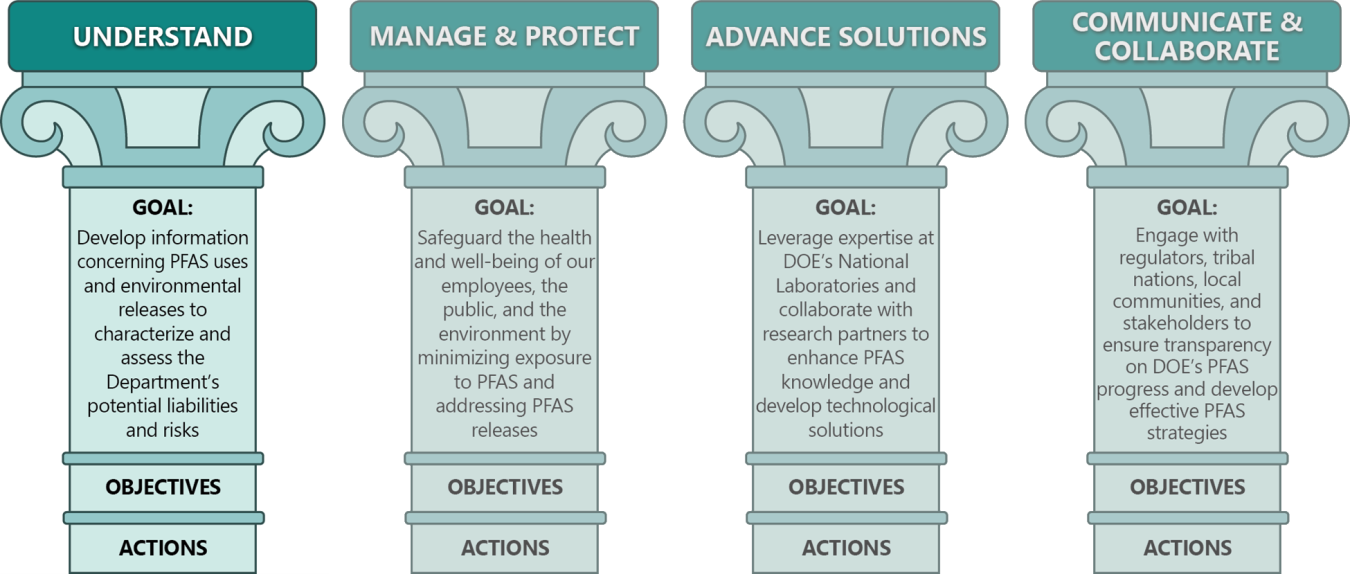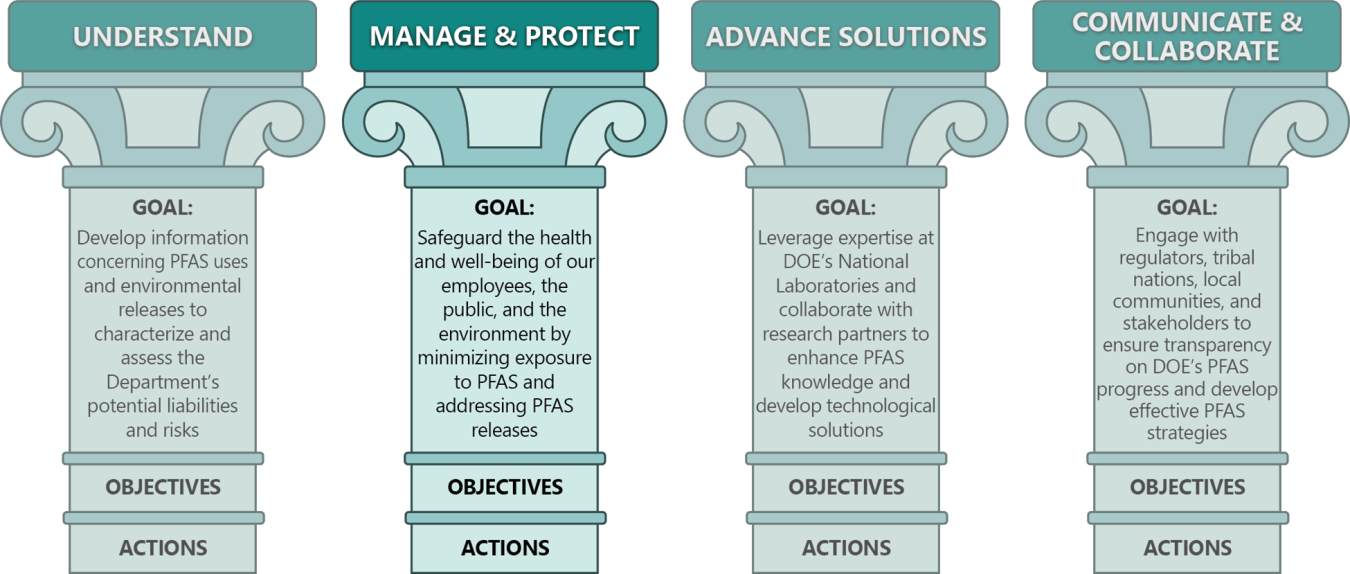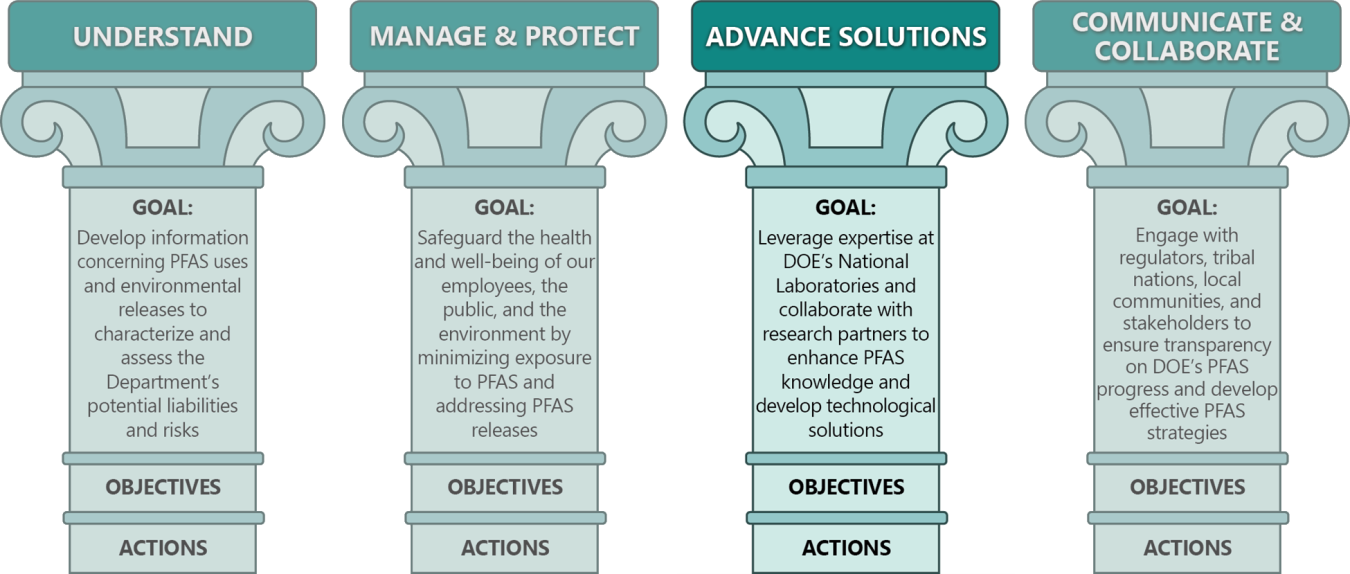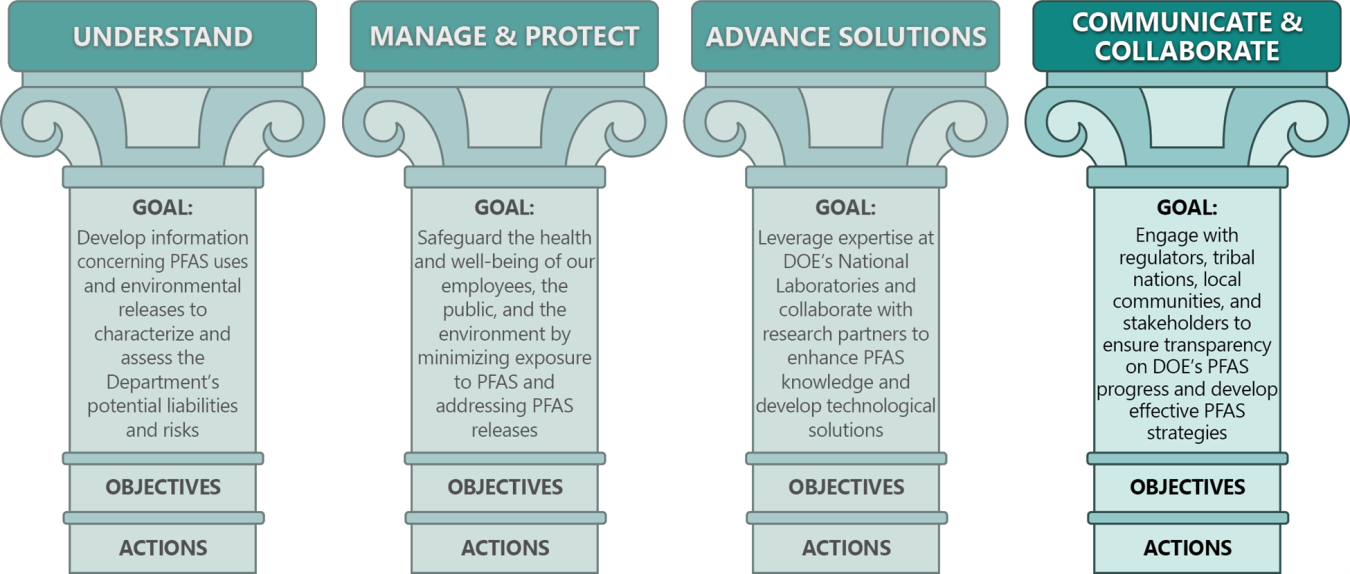DOE Approach
Four pillars encapsulate the Department’s overall approach, goals and objectives in addressing PFAS, and its planned actions to assess and manage PFAS risk at DOE sites:

GOAL 1:
Develop information concerning PFAS uses and environmental releases to characterize and assess the Department’s liabilities and risks.
OBJECTIVES:
- Objective 1 – Understand the Manhattan Project and Cold War-era sources and volumes of PFAS used and disposed of, with initial focus on uranium processing operations.
- Objective 2 – Assess Aqueous Film Forming Foam (AFFF) releases to the environment from fire suppression systems, firefighter training operations, and emergencies resulting in AFFF use.
- Objective 3 – Identify other PFAS uses and disposal activities associated with research, operations, and equipment maintenance.
- Objective 4 – Understand the presence of PFAS in drinking water and the environment.
- Objective 5 – Catalogue and track current PFAS inventories and uses.
ACTIONS:
- Publish DOE PFAS Preliminary Assessment Report. This report is DOE’s first broad investigation into the presence of PFAS at DOE sites. Results from this report will inform future data collection activities.
- Publish DOE guidance on historical and current use searches. The Preliminary Assessment Report offers a cursory look at historical and current uses. This action will support the execution of expanded DOE records search efforts.
- Test for PFAS at all DOE-owned water systems, where DOE supplies drinking water to a site, using the most recent U.S. Environmental Protection Agency (EPA) test method (537.1). Understanding the presence of PFAS in drinking water at DOE sites is a critical action and must be addressed at sites that have not yet tested their on-site sources. Ingestion of drinking water is a primary exposure pathway of PFAS. This action should include periodicity for re-testing when PFAS are detected or as otherwise appropriate.
- Complete initial assessment of classified records held at DOE-Germantown and the National Archives-College Park for information regarding PFAS use in nuclear production and research activities in the Manhattan Project and early Cold War.
- Identify relevant records (classified and open) held at DOE sites and Federal Records Centers and complete initial scoping efforts to identify likely PFAS use in historical and current DOE production and research activities.
- Publish environmental sampling guidance to support determining the nature and extent of PFAS releases at DOE sites, following the Data Quality Objectives process. This will establish consistency and robustness when executing site assessments.
- Perform site field assessments, as appropriate, and provide an annual site-specific status update to the PCC. In coordination with their regulatory partners, sites will conduct environmental investigations based on information collected from the Preliminary Assessment Report and follow-on records searches.
- Publish DOE PFAS Updated Status Report. The Updated Status Report will provide a consolidated representation of DOE’s risk associated with the presence of PFAS at its sites and include updates on addressing the actions identified in this Roadmap. The report will inform future decisions to manage the protection of human health and the environment.

GOAL 2:
Safeguard the health and well-being of our employees, the public, and the environment by minimizing exposure to PFAS and cleaning up PFAS contamination.
OBJECTIVES:
- Objective 1 – Minimize risks to the DOE workforce from exposure to PFAS.
- Objective 2 – Reduce risk to the public and environment.
- Objective 3 – Restrict procurement and use of PFAS-containing products and identify alternatives.
ACTIONS:
- Provide alternative drinking water supply to DOE sites where PFAS is detected in treated on-site drinking water at concentrations exceeding federal or state regulations. The health of our workforce is a fundamental priority for DOE.
- Establish requirements to restrict any non-emergency use of PFAS-containing AFFF, suspend disposal actions unless approved by head of program element, require PPE for operations with known PFAS exposure, and report PFAS spills and releases. This Action implements the DOE PFAS Policy Memorandum.
- Properly manage and dispose of PFAS-containing materials and wastes. Support the effective implementation of the Policy by developing internal guidance to inform the ongoing maintenance and use of PFAS-containing systems at DOE facilities, and to support the handling, storage, and disposal of PFAS-containing materials and wastes. This will ensure protection of workers, the public, and the environment and reduce Departmental liabilities and risks.
- Compile, maintain, and share a set of applicable resources to assist DOE sites with identifying and minimizing PFAS risks. The Department will identify resources to inform risk management approaches appropriate for use at sites where the presence of PFAS in the environment is found or suspected. The resources will describe tools and methods that are appropriate for characterizing the extent of contamination, assessing the possibility for imminent hazards, and exploring potential means for containment and/or remediation. These resources may also support notification and dialogue with relevant regulators. This action is expected to evolve as regulatory requirements are proposed or issued and as research and approvals advance on PFAS toxicology, treatment, and disposition methods.
- Develop/update procurement guidance to restrict the purchase of PFAS-containing products. The DOE GreenBuy Program provides specific guidelines for avoiding the purchase of PFAS-containing products. The latest guidance is updated to strengthen the PFAS restrictions and align with Executive Order and EPA requirements for purchase of PFAS-containing products.
- Issue Departmental Guidance on identifying PFAS and other emerging contaminants as a significant aspect within site Environmental Management Systems as appropriate, perhaps in the framework of the policy/directives changes identified by the PFAS Coordinating Committee.

GOAL 3:
Leverage expertise at DOE’s National Laboratories and collaborate with research partners to enhance PFAS knowledge and develop technological solutions.
OBJECTIVES:
- Objective 1 – Leverage the expertise of DOE National Laboratories and research partners to identify and advance research objectives.
- Objective 2 – Coordinate with federal agencies and research partners to solve challenges.
- Objective 3 – Conduct research and adapt strategies as needed.
- Objective 4 – Support Department-wide collaboration to enable deployment of solutions for PFAS-related challenges.
ACTIONS:
- Publish a PFAS Research Plan that identifies research gaps and establishes DOE research priorities to ensure a coordinated effort across DOE laboratories and other federal research partners. Enable coordination and provide direction for DOE’s research and development activities led by the national laboratories and other research institutions focused on evaluating promising technological approaches for PFAS detection, separation, destruction, and disposal. Identify deployment opportunities for promising technologies.
- Engage with interagency partners and external organizations to inform the Department’s PFAS research activities and strategy. DOE will remain involved with interagency processes coordinated through the White House, collaborate with other appropriate agencies and organizations, and maintain its close coordination with the Department of Defense (DOD), especially on analytical chemistry.
- Advance technologies and applied research at DOE National Laboratories and affiliate research programs. DOE National Laboratories and Research Partners are engaged in a range of applied technology development efforts to identify and deploy solutions to PFAS challenges.

GOAL 4:
Engage with regulators, tribal nations, local communities, and stakeholders to ensure transparency on DOE’s PFAS progress and develop effective PFAS strategies.
OBJECTIVES:
- Objective 1 – Develop publicly-available resources to provide timely updates on Departmental progress in assessing and managing PFAS risks.
- Objective 2 – Ensure effective engagement with community stakeholders, tribal, state and local governments, regulatory entities, and others.
ACTIONS:
- Release public-facing platform to serve as a central hub and resource center. Establish centralized DOE PFAS website conveying Departmental information including policies, practices and updates on engagement opportunities.
- Develop informational materials conveying DOE-wide and site-specific information including updates on PFAS developments. Identify content to provide timely, substantive updates on PFAS developments at the Department to support site-level and corporate communications efforts.
- Identify opportunities at the enterprise and site level to discuss PFAS issues with tribal, state and local governments, and interagency and external stakeholders. Engage with interested parties to hear concerns, gather input, and identify environmental justice considerations. Opportunities may include joining ongoing tribal consultation processes, scheduling virtual and in-person public meetings and other forums.
- Establish open communication channels to receive stakeholder-provided information and answer public inquiries, to support transparency in Departmental PFAS posture, policy and actions. Incorporate PFAS concerns and information into site and program communications and public engagement efforts.

